1. Early Life and Revolutionary Activities
Kliment Voroshilov's early life was marked by hardship and his early exposure to revolutionary ideas shaped his future political and military career.
1.1. Birth and Family Background
Kliment Voroshilov was born on 4 February 1881, in the settlement of Verkhnyeye, Bakhmut uyezd, Yekaterinoslav Governorate, Russian Empire. This area is now part of Lysychansk city in Luhansk Oblast, Ukraine. His father, a former soldier, worked variously as a railway worker and a miner, experiencing periods of unemployment. According to Soviet Major General Petro Grigorenko, Voroshilov himself acknowledged his Ukrainian heritage and that the family's earlier name was Voroshylo. In his published autobiography, Voroshilov recounted a childhood of extreme poverty and frequent beatings from wealthy peasants, which instilled in him a lifelong aversion to 'kulaks', or affluent farmers.
1.2. Education and Early Work
Voroshilov grew up illiterate, eventually enrolling in a newly opened school in a nearby village at the age of 12, where he received two years of formal education (1893-1895) at the Vasilyevka parish Zemskaya school in Slavyanoserbsk district. During his school years, he formed a close friendship with his teacher, Semyon Ryzhkov, who later became the Second Secretary of the First State Duma. In 1896, Voroshilov began working at a factory near his home village, where he led a strike in 1899, resulting in his dismissal. In 1903, he found employment at a German-owned factory in Luhansk (which was later renamed Voroshilov during the Stalin era).

1.3. Joining the Bolsheviks
While working at the factory in Luhansk in late 1903, Voroshilov joined the Bolsheviks, a faction of the Russian Social Democratic Labour Party (RSDLP). By 1904, he had become a member of the Luhansk Bolshevik Committee and a leader in strike movements. In April 1906, using the pseudonym 'Volodya Antimekov' or Anti-Menshevik, he traveled to Stockholm to attend the Fourth Congress of the RSDLP. It was in Stockholm that he shared a room with the delegate from Georgia, Josif Dzhugashvili, who would later be known as Joseph Stalin. In the spring of 1907, he attended the Fifth RSDLP Congress in London, where he met other prominent Bolshevik figures such as Mikhail Frunze and Mikhail Kalinin. His early political activities involved leading worker strikes and forming combat groups.
1.4. Role in the 1905 Revolution and Exile
Voroshilov's involvement in the Russian Revolution of 1905 saw him as a strike leader, leading to his arrest and subsequent release. He was active in underground party work in Baku, Petrograd, and Tsaritsyn between 1908 and 1917. He faced repeated arrests and exiles throughout his early revolutionary career. In late September 1907, Minister of Internal Affairs Pyotr Stolypin ordered Voroshilov's exile to Arkhangelsk province for three years under police supervision. However, he escaped in December 1907 and fled to Baku, where Stalin was also active. Arrested again in 1908, he was detained in the "Kresty" prison and later exiled to Mezen and then to the remote village of Doloda Slit in the White Sea region, near the Arctic Circle. Despite illness and exhaustion from hunger strikes, he continued to establish connections with political exiles and engage in political work among the local population.
In March 1912, he was relocated several times due to his "unacceptable behavior" and was eventually released from police surveillance in July 1912. He returned to Arkhangelsk and then moved to Donbass. In March 1913, following two more arrests, he was exiled to Cherdyn district in Perm Governorate for two years. His revolutionary activities were largely clandestine, and he received an amnesty in 1913, related to the 300th anniversary of the House of Romanov, which reduced his exile by one year. In March 1914, Voroshilov, accompanied by his future wife, Ekaterina Davydovna, moved to Donbass. Unable to find work in Luhansk due to heightened police surveillance, he was forced to leave. With the outbreak of World War I, he moved to Tsaritsyn, where he worked at an artillery factory and was exempt from military service under Imperial Russian law.
2. Russian Civil War and Military Career
2.1. Participation in the Russian Revolution
During the February Revolution of 1917, Voroshilov was in Petrograd (now Saint Petersburg), but he soon returned to Luhansk, where he became chairman of the town soviet and was elected to the Russian Constituent Assembly. His military career began in early 1918 when he was appointed commander of the Fifth Ukrainian Army, a collection of scattered units that were eventually driven out of Ukraine by the German army. After a perilous retreat, his group reached Tsaritsyn (later Volgograd), where Stalin was stationed as a representative of the central party leadership. In November 1917, following the October Revolution, Voroshilov served as the Political Commissar for the Petrograd Revolutionary Military Committee. He collaborated with Felix Dzerzhinsky in organizing the Cheka, the Soviet secret police. He was a delegate to the 7th All-Russian Conference and the 6th Congress of the RSDLP. In March 1917, he became Chairman of the Luhansk Bolshevik Committee, and by September, he was Chairman of the Luhansk Soviet. In early March 1918, Voroshilov organized the First Luhansk Socialist Partisan Detachment, which defended the city of Kharkiv from German-Austrian forces. As a Bolshevik delegate to the Russian Constituent Assembly, he opposed the formation of a centralized army.
2.2. Command during the Civil War
During the Russian Civil War, Voroshilov played a significant role, particularly in the 1918 Battle of Tsaritsyn. He was given command of the Tenth Army, and alongside Stalin, he led the Red Army's defense of Tsaritsyn against the White Army. They also supported the formation of the first Red Cavalry unit, commanded by Semyon Budyonny, which was largely composed of peasants from southern Russia. However, Voroshilov clashed with Leon Trotsky, the People's Commissar for War, who considered him undisciplined and unfit for army command. In October 1918, Trotsky reportedly threatened him with a court-martial, famously remarking, "Voroshilov is a fiction."
Voroshilov was subsequently transferred to Ukraine, serving as commander of the Kharkiv military district and later as People's Commissar for War in the Ukrainian Soviet Republic. He aligned himself with the 'Military Opposition', a faction that opposed the creation of a centralized army and preferred to rely on local mobile units. They also objected to the recruitment of former officers from the Tsarist army into the Red Army. Later, during the Polish-Soviet War, Voroshilov served as a political commissar with Budyonny's First Cavalry Army. While responsible for the morale of this unit, he was unable to prevent its defeat at the Battle of Komarów (1920) or the regular outbreaks of brutal anti-Semitic violence within its ranks. He was also Commander of the 5th Army, Tsaritsyn Front, Deputy Commander, and a member of the Military Council of the Southern Front, as well as the Commander of the 14th Army and the Ukrainian Internal Front. In March 1919, he participated in the "military conservative faction" at the 8th Congress of the Russian Communist Party (Bolsheviks). In 1921, he led a group of delegates to the 10th Congress of the Russian Communist Party and participated in the suppression of the Kronstadt Rebellion.

2.3. Relationship with Stalin
Voroshilov's close personal and political relationship with Joseph Stalin began during the defense of Tsaritsyn in 1918. He was known for defending Stalin in the military committee led by Trotsky, who was a rival of Stalin. Voroshilov actively promoted Stalin's image and role in the Civil War. In 1929, he published an article, later expanded into a book titled "Stalin and the Red Army," in which he praised Stalin as one of the "most outstanding organizers of the Civil War victory," a "true strategist," and a "first-class military leader with brilliant foresight." However, their relationship was not without friction; Voroshilov is known to have clashed with Stalin over foreign policy in China and the immediate expulsion of Trotsky and Zinoviev from the Central Committee. In July 1927, Vyacheslav Molotov even complained in a letter to Stalin that "Voroshilov has disrespected the comrade's leadership for the past two years."
2.4. Clashes with Political Rivals
From the early stages of his military and political career, Voroshilov engaged in conflicts with other prominent Bolshevik figures. His most notable early clash was with Leon Trotsky during the Civil War, whom he opposed as part of the 'Military Opposition' that resisted Trotsky's efforts to centralize the Red Army and incorporate former Tsarist officers. As he rose through the party ranks, his loyalty to Stalin led him to denounce other rivals. During the Great Purge in the 1930s, he actively supported the repression of figures like Grigory Zinoviev, Lev Kamenev, Nikolai Bukharin, and Alexei Rykov, whom he publicly condemned as "renegades." He also harbored personal animosity towards Mikhail Tukhachevsky, which influenced his stance during Tukhachevsky's downfall.
3. Interwar Period and Military Modernization
3.1. Political Rise within the Communist Party
Kliment Voroshilov's political influence steadily grew in the interwar period. He served as a member of the Central Committee from his election in 1921 until 1961. In April 1921, he was appointed commander of the North Caucasus Military District, a post he held until 1924. In March 1924, he was promoted to commander of the Moscow Military District. His most significant ascent occurred in 1925, following the death of Mikhail Frunze. Voroshilov was appointed People's Commissar for Military and Navy Affairs and Chairman of the Revolutionary Military Council of the USSR, a position he held until 1934. He became a full member of the newly formed Politburo in 1926, retaining this membership until 1960. Despite holding these high offices, he was not initially part of the inner circle of leadership. In November 1930, Sergey Syrtsov, the chairman of the Russian government, alleged that a "tiny group," which excluded Voroshilov but included less senior figures, was making decisions "behind the back of the Politburo."
3.3. Defense Commissar and Marshal of the Soviet Union
In 1934, the People's Commissariat for Military and Navy Affairs was reorganized into the People's Commissariat for Defense, and Voroshilov was appointed the first People's Commissar (Minister) for Defense, a position he held until 1940. In 1935, a major military reform reintroduced personal military ranks, and Voroshilov was among the first five high-ranking commanders to be awarded the new military rank of Marshal of the Soviet Union. He held the top military position for nearly 15 years, a record tenure in Soviet history.

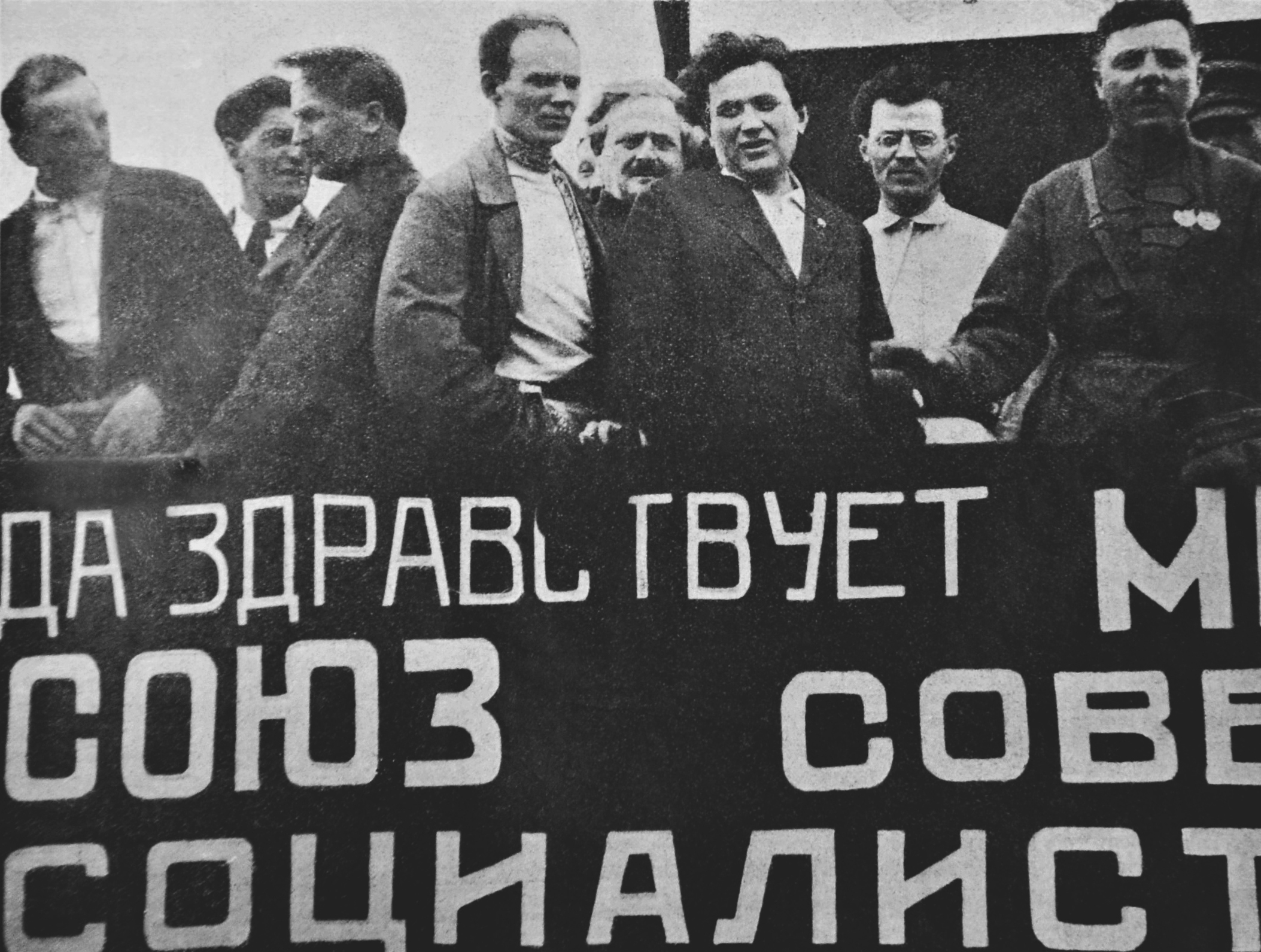
3.4. Industrialization and Military Reforms
During his long tenure as head of the Soviet military, Voroshilov played a crucial role in strengthening the country's defense capabilities. One of his major accomplishments was initiating the strategic relocation of key Soviet war industries east of the Ural Mountains. This policy, conceived as a means of allowing the Soviet Union to strategically retreat in the event of an invasion while preserving its manufacturing capacity, proved vital during World War II.
Under Voroshilov's leadership, the Red Army underwent extensive rearmament with modern weaponry, including new models of tanks, aircraft, and artillery. He actively engaged with designers and visited factories to inspect the quality of new military equipment. He also organized special committees, comprising experienced military experts such as Nikolay Voronov, Vladimir Grendal, Matvey Zakharov, and Georgy Savchenko, to test and evaluate the combat effectiveness of new artillery systems. New ranks, insignia, and uniforms were also approved for the Red Army.
A significant reform was the transition of the Red Army from a local militia system to a regular staffing system. After the Civil War, the Red Army adopted a mixed recruitment system that combined regular army structures with local militia units, primarily due to economic constraints. However, this system proved inadequate for ensuring consistent combat readiness, political training, cohesion, and discipline. Voroshilov noted that territorial units were unable to train conscripts in modern technology, openly proclaiming the system as insufficient in an era where imperialist powers were expanding their armies' capabilities. The unpopular and ineffective territorial units, where conscripts like Alexey Grigorovich Maslov reported never firing a shot during training, were gradually phased out. By 1939, local militia formations were completely eliminated from the Red Army's structure, reflecting the Soviet Union's growing economic potential.
Furthermore, Voroshilov completed the reorganization of military personnel training. Military education was divided into two main categories: non-commissioned officers (graduates of regular military schools) and officers (graduates of military academies). By 1926, 75% of the Red Army's 48,000 commanders were graduates of either military schools or short-term courses. By early 1928, the Soviet Union had 49 military schools, 6 military academies, and 5 departments within civilian academies. From 1929 onwards, there was a particular emphasis on increasing the number and capacity of technical universities.
According to a study by Oleg Ken, Voroshilov, in his role as People's Commissar for Military and Navy Affairs, advocated for the balanced development of the armed forces, taking into account the country's economic capabilities. He believed that the primary focus should be on strengthening the nation's economic position and expanding its economic base in preparation for war. He stated that military equipment required substantial financial resources and could only be sustained by a robust economy, warning that over-militarization could harm production. This approach, however, faced strong opposition from military technocrats starting in 1930, who often disregarded social and economic planning realities.
4. Involvement in the Great Purge

Kliment Voroshilov played a central and active role in Stalin's Great Purge of the 1930s, acting as an executor of Stalin's repressive policies. He denounced many of his own military colleagues and subordinates, often under duress or political pressure from Stalin himself.
4.1. Role in Military Purges
Initially, Voroshilov seemed to believe that the purge would not extend to the armed forces and appeared unprepared for the arrests of Marshal Mikhail Tukhachevsky and other prominent military figures in April and May 1937. He did not personally share the widespread paranoia towards upper-class elements of the officer corps and, in some instances, attempted to save the lives of officers such as Lukin, who would later serve with distinction in World War II, and Sokolov-Strakhov, sometimes succeeding. However, his complicity deepened over time. On 30 May 1937, he telephoned Iona Yakir, the commander of the Ukraine military district, ordering him to travel to Moscow for a meeting of the Military Revolutionary Council, knowing that Yakir would be arrested en route. When the Council convened on 1 June 1937, Voroshilov delivered a report, stating apologetically, "I could not believe we would reveal so many and such scoundrels in the ranks of the highest command of our glorious, our valiant Workers' and Peasants' Army."
4.2. Signing Execution Lists
Voroshilov was directly and extensively involved in the judicial murders of the Great Purge. He was one of four Politburo members (alongside Molotov, Stalin, and Lazar Kaganovich) who signed the order in August 1936, during the first of the Moscow Trials, dictating that appeals for clemency be denied and that the defendants be executed without delay. Furthermore, he personally signed 185 documented execution lists, placing him fourth among the Soviet leadership in terms of the number of signatures. These signatures condemned over 18,000 people to execution. He also approved numerous "limits" or quotas for repression, as mandated by NKVD Order No. 00447, which targeted former kulaks, criminals, and other "anti-Soviet elements." For instance, on a list of 26 Red Army officers sent from the NKVD to the People's Commissariat for Defense on 28 May 1937, Voroshilov wrote, "Comrade Yezhov. Arrest all these scoundrels. 28.5.1937. K. Voroshilov." A shorter note, "Arrest. K.V.," was found on a similar list of 142 officers.
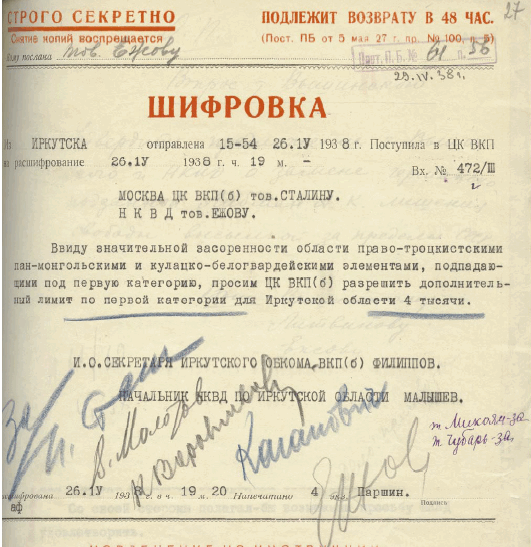

4.3. Denunciations of Colleagues
Voroshilov was instrumental in denouncing many of his former colleagues and subordinates, often under significant political pressure. At the March 1937 plenum of the Central Committee, he was a key speaker who publicly denounced Nikolai Bukharin and Alexei Rykov as "renegades," contributing to their subsequent arrests. He also had no qualms about denouncing officers he disliked, such as Marshal Tukhachevsky. In a particularly insidious act, he wrote personal letters to exiled former Soviet officers and diplomats, including Commissar Mikhail Ostrovsky, falsely reassuring them that they would not face retribution from authorities if they returned voluntarily to the Soviet Union. However, these reassurances were a trap; Ostrovsky, for example, was arrested in 1938, sentenced to 15 years, and died in prison in Norilsk in 1952.
Despite his participation in purging many "mechanizers" (supporters of tank warfare over cavalry) from the Red Army, Voroshilov eventually became convinced that reliance on cavalry should decrease and that more modern arms should receive higher priority. Marshal Budyonny attempted to recruit him to protect the status of cavalry in the Red Army, but Voroshilov openly declared his intention to do the opposite. He praised the army's combined arms warfare capabilities and the initiative of officers during the 1936 summer maneuvers. However, his full report also highlighted significant issues within the Red Army, including insufficient communication, ineffective staffs, inadequate cooperation between different branches, and the rudimentary nature of the command structure in tank units and other modern arms.
When the Great Purge concluded, some reforms were undertaken by the high command to align Red Army doctrine, such as deep operations, with the actual state of the Red Army. Politically appointed commanders, including Voroshilov and Grigory Kulik, recognized that the army, particularly after the purges, was ill-equipped to execute deep operations. While Voroshilov and Kulik were among the instigators of these reforms, which had a positive impact on the Red Army's theoretical framework, they proved unable to implement them effectively in practice. One of these reforms, a reorganization of Red Army field units, inadvertently moved the Red Army's organizational state to a less advanced level than it had been in 1936, a change conceived by Kulik but executed by Voroshilov.
When territorial units were abolished, Voroshilov noted that one of the reasons for their disbandment was their inability to train conscripts in the use of modern technology. He had openly declared the system inadequate in an era where imperialist powers, such as Nazi Germany, were rapidly expanding their armies' capabilities. These territorial units were widely unpopular not only with Voroshilov but with the Red Army leadership as a whole, proving to be hopelessly ineffective. Conscripts like Alexey Grigorovich Maslov noted that they never fired a shot during their training, and it was observed that these units only underwent real training for one month a year when experienced veterans returned.
5. World War II
5.1. Command during the Winter War

Kliment Voroshilov commanded Soviet troops during the Winter War against Finland from November 1939 to January 1940. However, due to severe Soviet planning deficiencies and Voroshilov's widely recognized incompetence as a general, the Red Army suffered staggering losses, with approximately 320,000 casualties compared to the Finnish forces' 70,000 casualties. When the Soviet leadership convened at Stalin's Kuntsevo Dacha to address the failures, Stalin reportedly shouted at Voroshilov for the immense losses. In a rare display of defiance, Voroshilov retorted, blaming the catastrophe on Stalin himself for eliminating the Red Army's best generals during his purges. This outburst reportedly culminated in Voroshilov smashing a platter of food on the table, an incident Nikita Khrushchev later recounted as the only time he witnessed such an explosion of temper from Voroshilov.
Despite this confrontation, Voroshilov was made the primary scapegoat for the initial failures in Finland. He was subsequently replaced as Defense Commissar by Semyon Timoshenko in March 1940 and was reassigned to the less militarily demanding role of Deputy Premier, with responsibility for cultural matters. In a grim decision, Voroshilov, who had initially argued for the release of thousands of Polish army officers captured in September 1939, later signed the order for their execution in the infamous Katyn massacre of 1940.
5.2. Role in the State Defense Committee
Between 1941 and 1944, Voroshilov served as a member of the State Defense Committee (GKO), the supreme wartime authority, as well as a member of the Stavka (Soviet high command). His presence in these crucial bodies, despite his military shortcomings, underscored Stalin's political need for a loyal, recognizable figurehead from the Old Bolshevik guard during the war.
5.3. Command during the German Invasion
Following Operation Barbarossa, the German invasion of the Soviet Union in June 1941, Voroshilov was initially appointed commander of the short-lived Northwestern Direction (July to August 1941), which controlled several fronts. In September 1941, he commanded the Leningrad Front. Working alongside military commander Andrei Zhdanov as German advances threatened to encircle Leningrad, Voroshilov displayed considerable personal bravery, notably in defiance of heavy shelling at Ivanovskoye. At one point, he reportedly rallied retreating troops and personally led a counter-attack against German tanks, armed only with a pistol. However, this style of counterattack was considered outdated by military strategists and drew contempt from his military colleagues. Ultimately, he failed to prevent the Germans from surrounding Leningrad, and he was dismissed from his command on 8 September 1941, replaced by the far more capable Georgy Zhukov.
On 6 September 1942, Voroshilov was appointed Commander-in-Chief of the partisan movement. In this capacity, he significantly contributed to the development of the partisan movement, particularly by improving the management of partisan forces. The control scheme he introduced proved highly effective on the front lines and remained largely unchanged until the end of the war. Through Voroshilov's efforts, the Central Headquarters of the Partisan Movement became a powerful body for controlling partisan forces, addressing issues related to training, logistics, air transport, and other critical aspects of the movement. However, this position was abolished on 19 November 1942, a decision that Ilya Starinov, a renowned partisan expert, believed had a negative impact on the movement.
On 5 April 1943, by resolution of the State Defense Committee, Voroshilov was appointed Chairman of the Occupation Commission. This commission, along with the reorganization of occupation management bodies, began forming new occupation units in April 1943. By the summer of 1943, a clear structure for the Red Army's occupation units was established, significantly strengthening their service and positively impacting their work. In addition to addressing national economic issues, the occupation units actively helped people liberated from German occupation. They also handled the crucial task of collecting, safeguarding, accounting for, disposing of, and transporting weapons, military equipment, and other military and economic assets captured from the enemy. On 3 April 1944, Voroshilov approved and published the "New Regulations on the bodies, units, and organizations of the Red Army," which provided the most comprehensive regulations for occupation service. The commission was eventually abolished in February 1945.
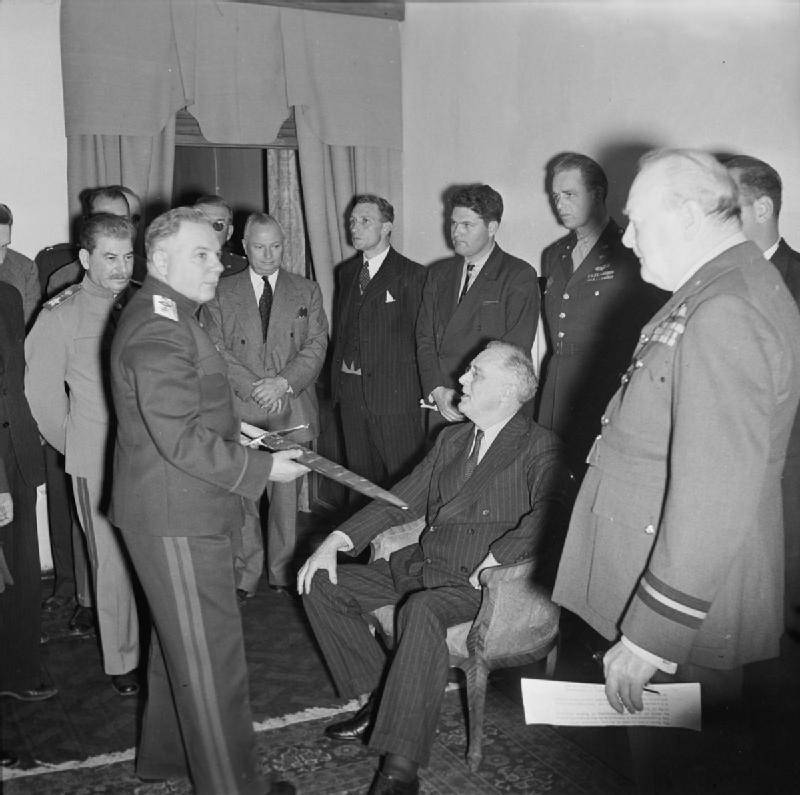
5.4. Participation in Allied Conferences
Voroshilov was also involved in significant wartime conferences, representing the Soviet Union on the international stage. In December 1943, he participated in the Tehran Conference in Iran, where he was present alongside Stalin, Churchill, and Roosevelt. During this conference, he was notably observed presenting the Sword of Stalingrad to U.S. President Franklin D. Roosevelt. In 1943, Voroshilov also headed the Armistice Commission, an body that played a decisive role in establishing the terms for Germany's unconditional surrender. The commission's first major development under his leadership was the "Document on Germany's Unconditional Surrender" dated 3 February 1944. The final report on the commission's work was issued on 14 February 1946.
6. Post-War Activities and Political Leadership
6.1. Supervision of Hungarian Regime
Following World War II, between 1945 and 1947, Voroshilov oversaw the establishment and consolidation of the socialist regime in Hungary. He served as the Chairman of the Allied Control Commission (ACC) in Hungary, which began its operations in Debrecen on 5 February 1945. The ACC's responsibilities included regulating and supervising the implementation of the armistice terms. The commission operated under challenging conditions due to internal divisions within Hungarian society, stemming from Hungary's unsuccessful attempts to withdraw from the war, which set the situation in Hungary apart from other German satellite states. Despite these difficulties, the commission successfully fulfilled its mandate and ceased operations once the peace treaty came into effect. Voroshilov notably attributed the Hungarian Communist Party's poor performance in the October 1945 Budapest municipal elections to the presence of minorities in leadership positions, arguing that it was "detrimental to the party that its leaders are not of Hungarian origin."
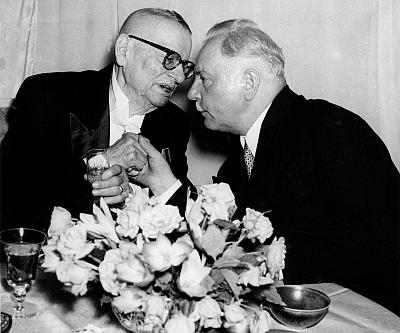
6.2. Role in Post-Stalin Power Struggles
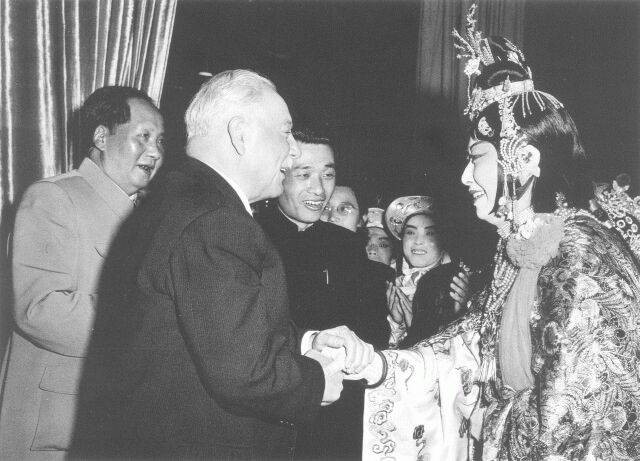
In 1952, Voroshilov was appointed a member of the Presidium of the Communist Party of the Soviet Union (the renamed Politburo). The death of Joseph Stalin on 5 March 1953 triggered significant shifts within the Soviet leadership. On 15 March 1953, Voroshilov was approved as Chairman of the Presidium of the Supreme Soviet (the equivalent of head of state), with Nikita Khrushchev becoming First Secretary of the Communist Party and Georgy Malenkov serving as Premier of the Soviet Union. Voroshilov, Malenkov, and Khrushchev quickly collaborated to orchestrate the arrest of Lavrenty Beria, the powerful head of the secret police, on 26 June 1953, effectively consolidating their power in the immediate aftermath of Stalin's death.
In 1956, when Khrushchev initiated the de-Stalinization campaign, Voroshilov briefly aligned himself with the conservative faction, including Malenkov, Lazar Kaganovich, and Molotov-the so-called "Anti-Party Group." This group attempted to oust Khrushchev in 1957. However, after Khrushchev emerged victorious in the power struggle in June 1957, Voroshilov swiftly switched his allegiance, siding with Khrushchev.
6.3. Chairman of the Presidium of the Supreme Soviet
As Chairman of the Presidium of the Supreme Soviet from 1953 to 1960, Voroshilov served as the nominal head of state of the Soviet Union. One of his key responsibilities in this role was to oversee the appeal review process for Soviet death row inmates. On 12 July 1954, through a decree of the Presidium of the Supreme Soviet, Voroshilov abolished the personal ranks, insignia, and uniforms for employees of Soviet civilian ministries and departments, which had been previously introduced by his predecessor, Nikolay Shvernik.
6.4. Review of Death Row Appeals
Analysis by Jeffrey S. Hardy and Yana Skorobogatov illuminates Voroshilov's role in reviewing appeals from Soviet death row inmates. As Chairman, Voroshilov presided over these meetings and clearly wielded significant influence, though split votes were not uncommon, and he was occasionally outvoted. Throughout his tenure as Presidium chair, he demonstrated a belief in adhering to established procedures and a cautious approach to matters of life and death. Hardy and Skorobogatov indicate that Voroshilov frequently used his influence to advocate for leniency, particularly for those who expressed repentance in their appeal documents, or those convicted of crimes of passion or offenses committed under the influence of alcohol. Conversely, he tended to judge those convicted of political crimes or acts motivated by financial gain more harshly. During his leadership, many death sentences were commuted to prison terms of varying lengths. The authors noted that his successor, Leonid Brezhnev, adopted a noticeably stricter stance in appeals cases.
This relatively magnanimous attitude towards pardon cases in the 1950s stood in stark contrast to his well-documented and active participation in the deadly purges of the 1930s. This contrast was not lost on contemporaries; Khrushchev famously questioned him, "So when were you acting according to your conscience, then or now?"
7. Fall from Grace and Later Life
7.1. Decline in Influence under Khrushchev
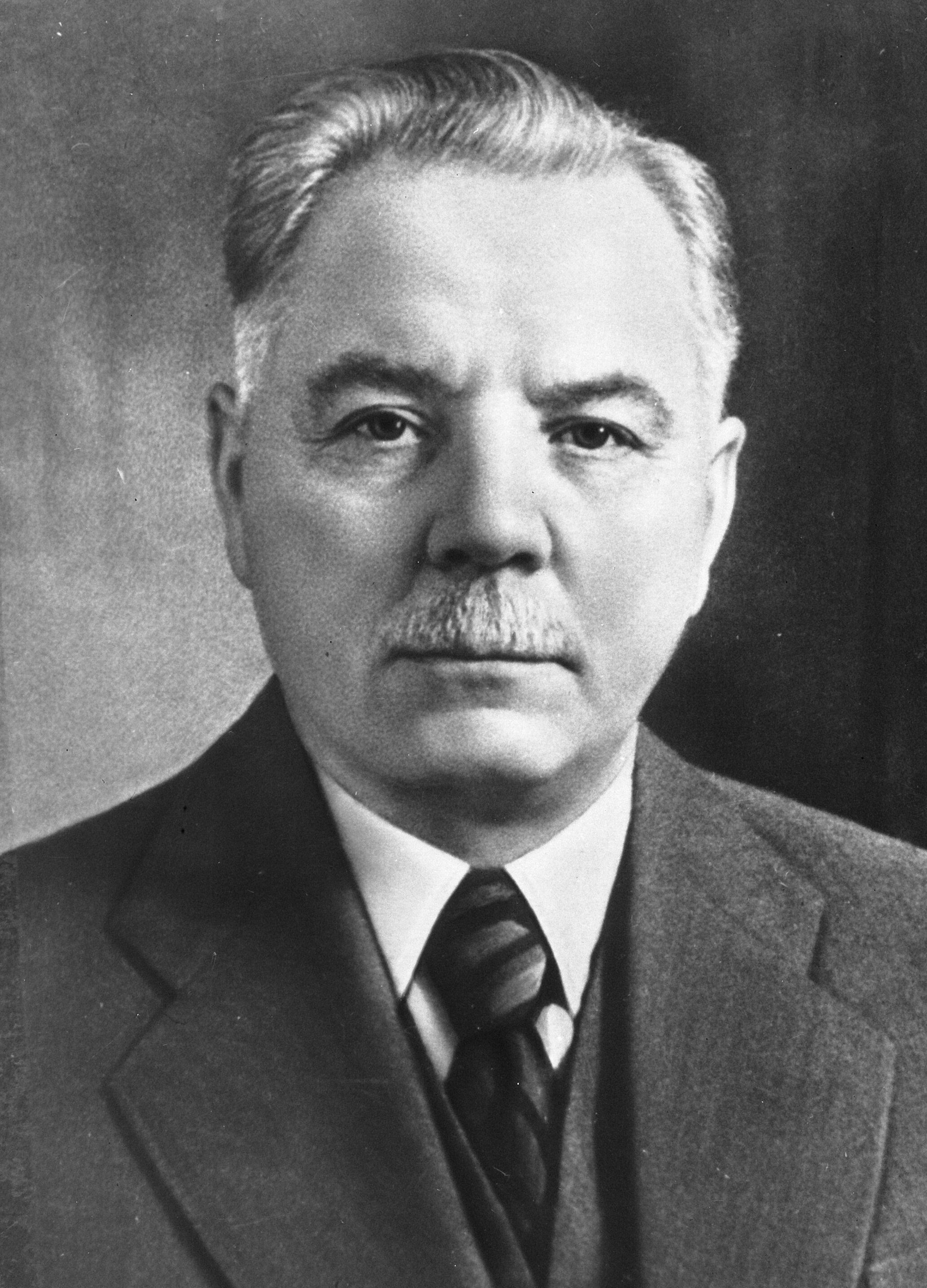
After Nikita Khrushchev successfully removed most of the prominent Stalinists, such as Molotov and Malenkov, from the party leadership, Kliment Voroshilov's career began to decline. His political standing and influence diminished significantly during Khrushchev's ascendancy.
7.2. Retirement and Exclusion from Central Committee
On 7 May 1960, the Supreme Soviet of the Soviet Union formally granted Voroshilov's request for retirement, marking the end of his tenure as head of state. Leonid Brezhnev was elected as his successor for Chairman of the Presidium of the Supreme Council. Two months later, on 16 July 1960, the Central Committee further stripped him of his duties as a member of the Party Presidium (the Politburo's name since 1952). His political defeat was finalized in October 1961 at the 22nd Party Congress, when he was excluded from election to the Central Committee. This exclusion effectively ended his active political career, and he transitioned into life as a pensioner. An anecdote suggests that at a Central Committee dinner shortly before his retirement, Voroshilov realized his impending removal when other members ignored him. Perceiving that his dismissal was already decided, he pre-empted it by formally requesting an honorable "retirement."
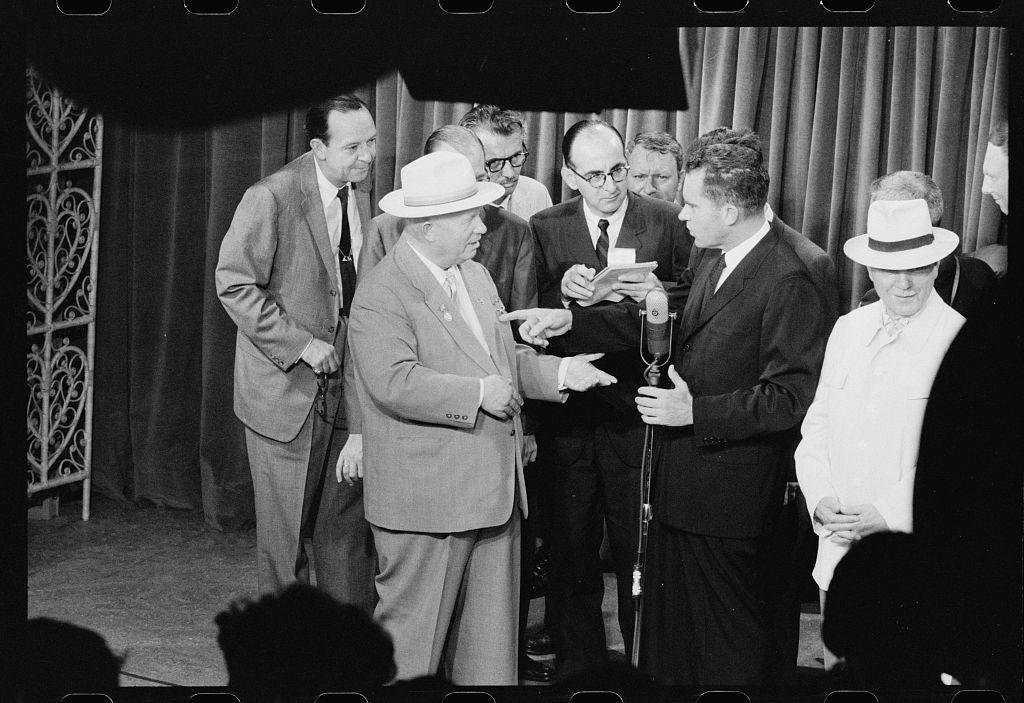
7.3. Return to Public Life under Brezhnev
Following Khrushchev's ouster from power, the new Soviet leader, Leonid Brezhnev, brought Voroshilov out of retirement, albeit into a largely symbolic political post. Voroshilov was re-elected to the Central Committee in 1966. In 1968, he was awarded a second Hero of the Soviet Union medal, a gesture that underscored his symbolic return to public life and official recognition under the Brezhnev administration.
8. Personal Life
8.1. Marriage and Family
Kliment Voroshilov was married to Ekaterina Voroshilova, born Golda Gorbman (1887-1959), a Ukrainian Jew from Mardarovka. They met while both were exiled in Arkhangelsk, where Ekaterina had been sent in 1906. Before their marriage in 1913, Ekaterina converted to Orthodox Christianity and changed her name to be allowed to marry Voroshilov. She became a Bolshevik Party member in 1917 and later worked as deputy director of the Lenin Museum.
The couple had no biological children but adopted several. While serving on the Tsaritsyn Front in 1918, where Ekaterina was helping orphans, they adopted a four-year-old orphan boy whom they named Petya (1914-1984), who later became a Lieutenant General in the Soviet Army. They also adopted the children of Mikhail Frunze-Timur Mikhailovich Frunze (1923-1942) and Tatyana Mikhailovna Frunze (born 1920)-following his death in 1925. Additionally, they adopted Leonid Lavrentyevich Nesterenko (1910-1986), the son of a mechanic from the Luhansk locomotive factory who had worked alongside Voroshilov and later died in the Civil War. During Stalin's rule, the Voroshilov family resided in the Kremlin at the Horse Guards.
8.2. Personality and Contemporary Accounts
Contemporary accounts and recollections of Kliment Voroshilov's personality are mixed. Vyacheslav Molotov, in 1974, described Voroshilov as "nice, but only in certain times." Molotov noted that Voroshilov consistently supported the party line, was from a working-class background, was a common man, and a good orator. He was also perceived as "clean." While personally devoted to Stalin, Molotov suggested this devotion was not always absolute. Voroshilov actively advocated for and supported Stalin in most matters, though Molotov believed he wasn't "entirely sure in everything." Molotov also highlighted the complex nature of their relationship, noting that Stalin often treated Voroshilov critically and did not invite him to private conversations; when Voroshilov came uninvited, Stalin would frown. Molotov attributed this strained dynamic to an incident during the Winter War, when Voroshilov, publicly reprimanded by Stalin for military failures, angrily retorted that the failures were due to Stalin's purges of competent generals. Molotov recounted that Voroshilov smashed a platter of food on the table in this rare outburst. Khrushchev, too, held a low opinion of Voroshilov's military capabilities, reportedly calling him the "biggest bag of shit in the army." He also noted that under Khrushchev, Voroshilov "behaved badly."
Despite his perceived lack of talent as a military commander, Voroshilov was considered adept in areas such as wartime economic construction. His pragmatic approach to maintaining political influence and his consistent loyalty to the Communist Party line were defining aspects of his career. His name also became widely known through popular culture; in the 1934 song "Polyushka-polye" (Meadowland), his name appears in seven of the ten stanzas, reflecting his prominent status. An anecdotal account from the time of the German invasion suggests a dramatic clash between Voroshilov and Stalin; after Leningrad was besieged, a frustrated Voroshilov is said to have slapped Stalin, cursed him, and successfully persuaded him to recall exiled commanders (including Georgy Zhukov) and cease the executions and dismissals of officers.
9. Ideology and Political Stance
Kliment Voroshilov's political beliefs were rooted in his early affiliation with the Bolsheviks and remained consistently aligned with the Communist Party line throughout his career. His pragmatic approach to politics was characterized by a strong commitment to maintaining his political influence and power within the Soviet system, primarily through unwavering loyalty to Joseph Stalin.
He was a staunch proponent of the centralized party structure and the suppression of any perceived opposition. His active participation in the Great Purge demonstrated his willingness to enforce Stalin's authoritarian policies, even at the cost of denouncing former colleagues and contributing to widespread repression. While he initially showed some reservations about the extent of military purges, his ultimate compliance highlights a pragmatic decision to prioritize his position and loyalty to Stalin over dissenting opinions.
In military doctrine, he evolved from initially favoring local mobile units and cavalry to recognizing the necessity of modernizing the Red Army with advanced weaponry like tanks and aircraft, even if his implementation of these reforms was flawed. This shift reflected a pragmatic adaptation to changing military realities, rather than a deep ideological conviction about military strategy. His consistent support for Stalin and the party's agenda, even when he harbored personal doubts or disagreements, underscores his pragmatic approach to political survival within a totalitarian regime.
10. Evaluation and Legacy
Kliment Voroshilov's legacy is complex and controversial, marked by both perceived achievements and significant criticisms.
10.1. Achievements and Positive Assessment
Voroshilov is credited with significant contributions to the modernization of the Soviet military during the interwar period. As People's Commissar for Defense, he oversaw the rearmament of the Red Army with advanced tanks, aircraft, and artillery, replacing outdated equipment. His strategic foresight in relocating key Soviet war industries east of the Ural Mountains proved crucial for the Soviet Union's defense capabilities during World War II, ensuring continued production even under invasion. He also reformed military education and transitioned the army from a mixed militia system to a fully professional, regular force, which was essential for a modern industrialized military.
His perceived loyalty and dedication to the Soviet state and to Joseph Stalin were central to his political longevity. He maintained a prominent role within the party leadership for decades, serving an unparalleled 15 years as head of the military apparatus and later as nominal head of state.
His name was honored in several ways during the Soviet era. The renowned Kliment Voroshilov (KV) series of heavy tanks, which saw extensive use in World War II, was named after him. Two towns were also named in his honor: Voroshilovgrad in Ukraine (now Luhansk) and Voroshilov in the Soviet Far East (now Ussuriysk, named after the Ussuri River). Additionally, the General Staff Academy in Moscow bore his name. The city of Stavropol was known as Voroshilovsk from 1935 to 1943. Beyond Soviet borders, he was made an honorary citizen of İzmir, Turkey, in November 1933, and a street in İzmir was named after him, though it was later renamed "Plevne Bulvarı" in 1951.
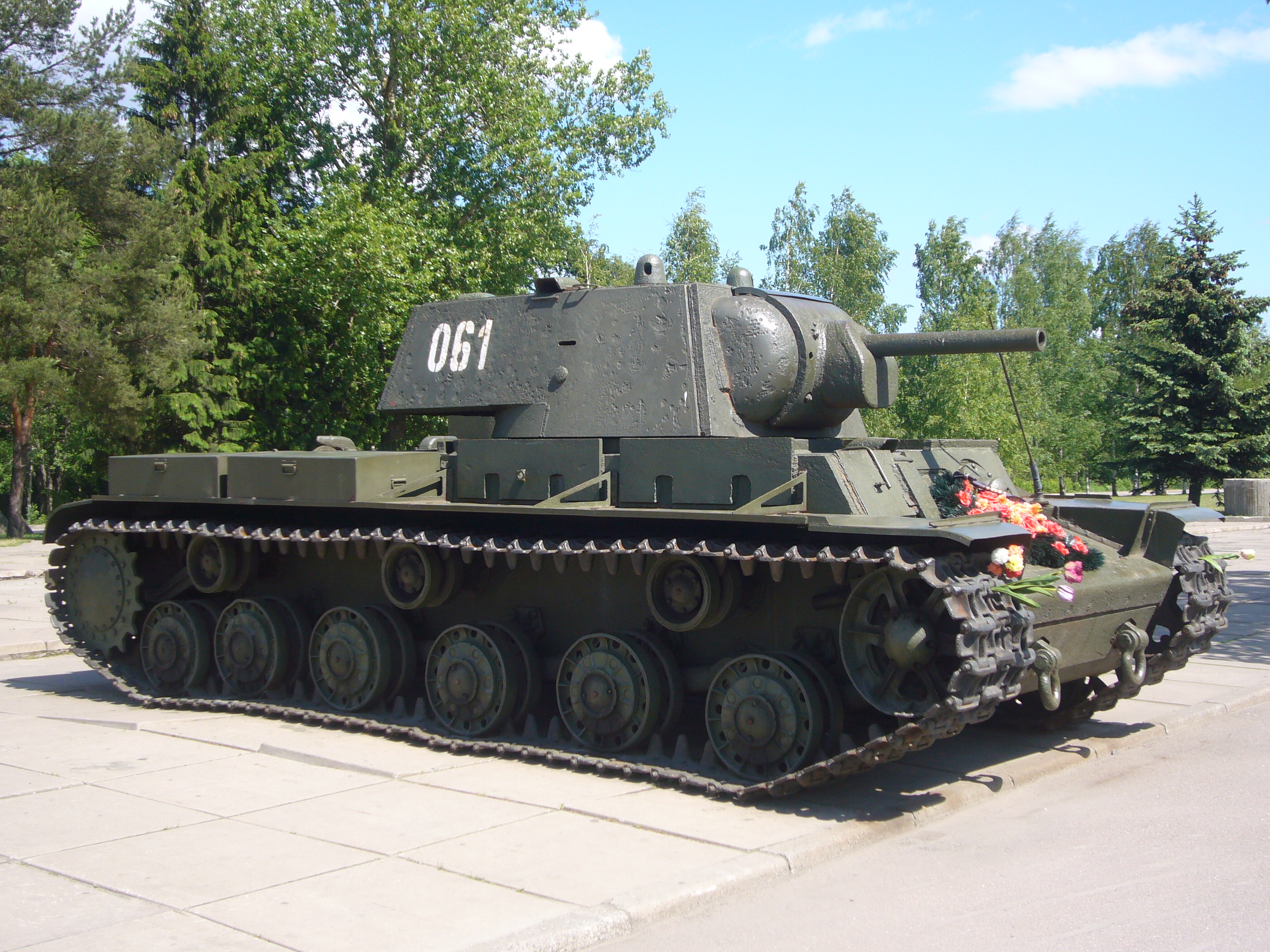
10.2. Criticism and Controversy
Despite his high positions and honors, Voroshilov is remembered with considerable criticism and controversy, particularly concerning his role in the Great Purge and his military leadership.
His active participation in the Great Purge of the 1930s stands as a major stain on his legacy. He is documented to have personally signed 185 execution lists, leading to the deaths of thousands, including many of his military colleagues. His denunciations of prominent figures like Nikolai Bukharin and Alexei Rykov, and his role in the show trials, highlight his deep involvement in the Stalinist repression. The stark contrast between his involvement in these brutal purges and his later, more lenient approach to death row appeals as head of state, as questioned by Khrushchev, underscores the moral ambiguity of his actions.
His military leadership, particularly during World War II, faced severe criticism for its failures and incompetence. His command during the Winter War against Finland (1939-1940) resulted in disproportionately high Soviet casualties due to poor planning and his strategic shortcomings, leading to his removal as Defense Commissar. Similarly, during the initial stages of the German invasion in 1941, his command of the Northwestern Direction and the Leningrad Front was ineffective, failing to prevent the encirclement of Leningrad and leading to his replacement by Georgy Zhukov. His attempts at counter-attacks were often described as outdated and drew contempt from his military colleagues. Khrushchev's dismissive private assessment of Voroshilov as the "biggest bag of shit in the army" reflects the low regard some contemporaries held for his military acumen. These criticisms often overshadow his contributions to military modernization, painting him as a politically loyal but militarily incompetent figure associated with the authoritarian policies and repression of the Stalin era.
11. Death
Kliment Voroshilov's health began to decline during the winter of 1969. On 2 December, at the age of 88, he passed away in Moscow. On the morning of his death, despite feeling unwell, he donned his military uniform, fully decorated, and insisted on taking a car to the hospital himself. He was interred with full state honors in the Kremlin Wall Necropolis, one of the twelve individual tombs located between the Lenin Mausoleum and the Kremlin Wall. His funeral was notable as the first state funeral for a high-ranking official since that of Andrei Zhdanov (excluding the reburial of Stalin), with a grave dug behind the Lenin Mausoleum.
12. Honors and Awards
Kliment Voroshilov received numerous Soviet and foreign honors throughout his long career.
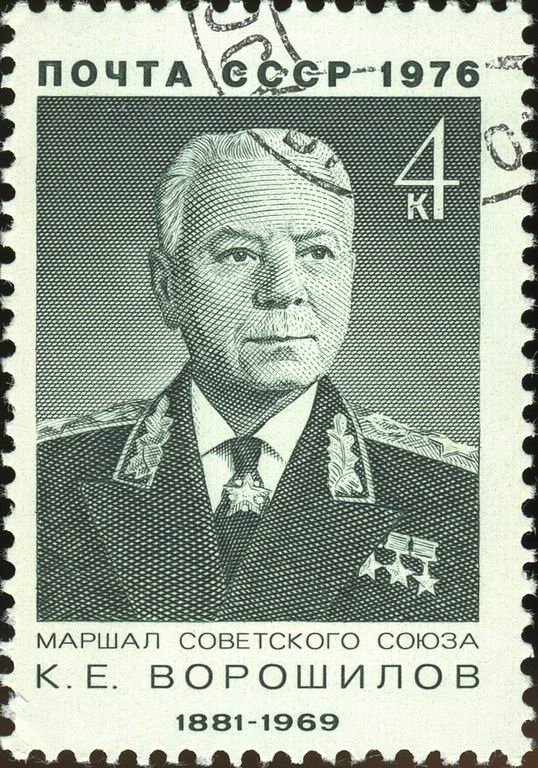
12.1. Soviet Union
- Hero of the Soviet Union, two times (3 February 1956, on his 75th birthday; 22 February 1968, on the 50th anniversary of the Armed Forces of the USSR)
- Hero of Socialist Labour (7 May 1960)
- Order of Lenin, eight times (23 February 1935, 22 February 1938, 3 February 1941, 21 February 1945, 3 February 1951, 3 February 1956, 3 February 1961, 22 February 1968)
- Order of the Red Banner, six times (26 June 1919, 2 April 1921, 2 December 1925, 22 February 1930, 3 November 1944, 24 June 1948)
- Order of Suvorov, 1st class (22 February 1944)
- Order of the Red Banner of the Uzbek Soviet Socialist Republic (17 February 1930)
- Order of the Red Banner of the Tajik SSR (14 January 1933)
- Order of the Red Banner ZSFSR (25 February 1933)
- Jubilee Medal "XX Years of the Workers' and Peasants' Red Army" (22 February 1938)
- Medal "For the Victory over Germany in the Great Patriotic War 1941-1945" (1945)
- Medal "For the Defence of Leningrad"
- Medal "For the Defence of Moscow"
- Medal "For the Defence of the Caucasus"
- Medal "In Commemoration of the 800th Anniversary of Moscow" (21 September 1947)
- Jubilee Medal "30 Years of the Soviet Army and Navy" (22 February 1948)
- Jubilee Medal "40 Years of the Armed Forces of the USSR" (17 February 1958)
- Jubilee Medal "50 Years of the Armed Forces of the USSR"
- Jubilee Medal "Twenty Years of Victory in the Great Patriotic War 1941-1945" (1965)
- Honorary Revolutionary Weapon (1920, 1968)
12.2. Foreign awards
12.2.1. Mongolia
- Hero of the Mongolian People's Republic (29 May 1957)
- Order of Sukhbaatar, twice
- Order of the Red Banner
- Order of the Polar Star
12.2.2. Finland
- Grand Cross of the Order of the White Rose of Finland (1955)
12.2.3. Turkey
- Honorary citizen of İzmir, November 1933.